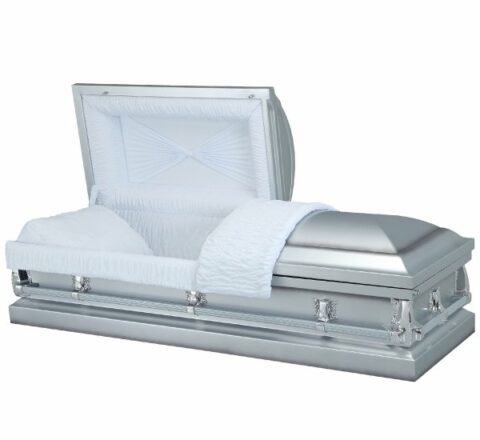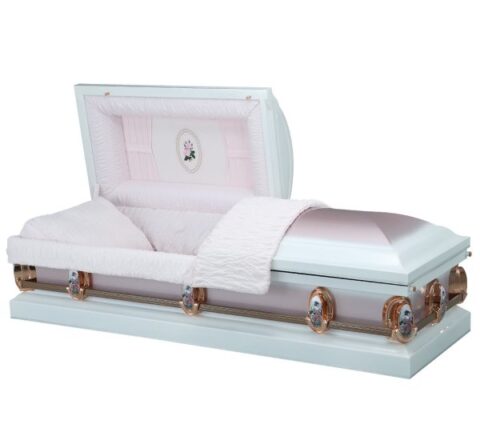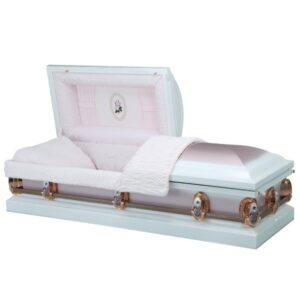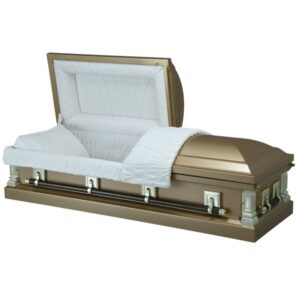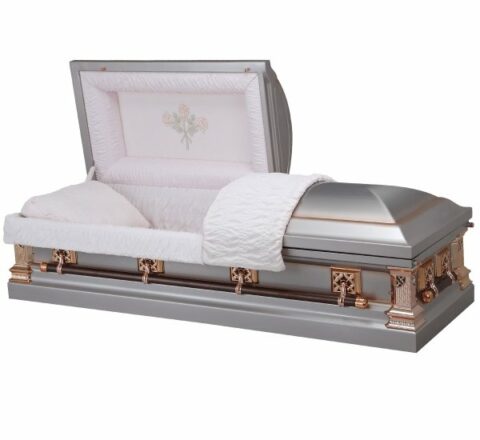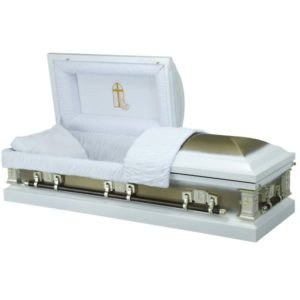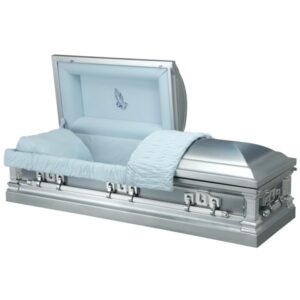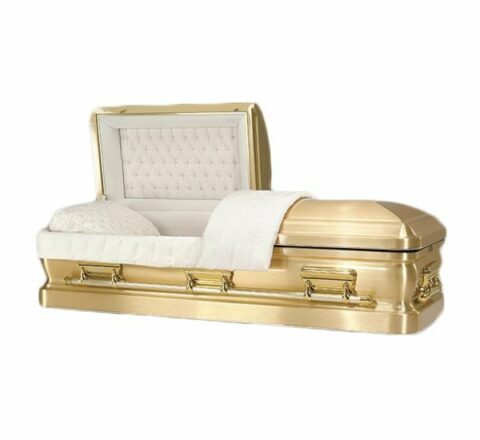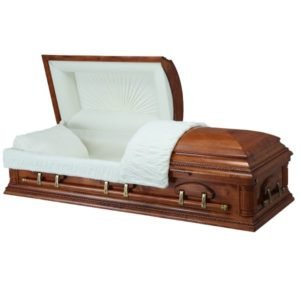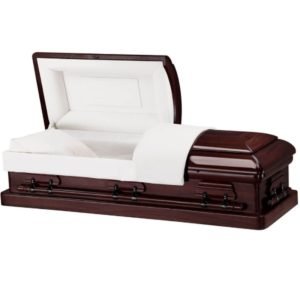These stylish and beautifully made caskets are either made of solid wood or Steel sheet. They come fully finished with quality plush linings, and include all fixtures and fittings that embellish the exterior of the caskets.
Choose From The Range Of American Casket Coffins
-
Quick View£3,855.00
Traditional American Casket, manufactured in USA from Cherry hardwood with braided trim detailing. Semi-polished with Champagne velvet interior with slit tufted panel. Inset urn-style corners, Wooden bar handle and antique gold fittings.
-
Quick View£2,845.00
Traditional American Casket, manufactured in USA from Solid Hardwood timber, finished in White with metal handlesAdjustable bed and mattressPlease notify us if you require a name and message to be added to the outside of the coffin.
-
Quick View£2,500.00
Premium Traditional American Coffin Casket hardwood Oak, manufactured in the USA, White cream interior with side pleated panel and Stationary hardware and handles. Beautifully lined in cream velvetAdjustable bed and mattressPlease notify us if you require a name and message to be added to the outside of the coffin.
-
Quick View£2,280.00
Premium Traditional American Coffin Casket hardwood Oak, manufactured in the USA, White cream interior with side pleated panel and Stationary hardware and handles. Beautifully lined in cream velvet and single panel lidAdjustable bed and mattressPlease notify us if you require a name and message to be added to the outside of the coffin.
-
Quick View£2,245.00
Premium Traditional Last Supper American Coffin Casket hardwood Mahogany, manufactured in the USA, White cream interior with side pleated panel and Stationary hardware and handles. Beautifully lined in cream velvet. An insert panel can be installed at an extra cost.Adjustable bed and mattress
-
£2,295.00
Premium Traditional American Coffin Casket in brushed steel, manufactured in the USA, White cream interior with side pleated panel and Stationary hardware and handles. Beautifully lined in cream and split panel lidAdjustable bed and mattressPlease notify us if you require a name and message to be added to the outside of the coffin.
Quick View -
Quick View£1,165.00
Imported from South Africa this Standard Domed Casket comes fully lined has been expertly designed and manufactured to a high standard.
-
Quick View£1,165.00
Imported from South Africa this Standard Domed Casket comes fully lined has been expertly designed and manufactured to a high standard.
-
Quick View£1,315.00
Imported from South Africa this Standard Domed Casket comes fully lined has been expertly designed and manufactured to a high standard.
-
Quick View£1,405.00
Click on picture of coffin to enlarge image. To view this page as a separate tab click here so it can be individually shared. To read more about American Caskets click here
-
Quick View£1,425.00
A 20-gauge steel casket in lilac, the pretty Neptune Orchid has decorative fixed bar handles and supports and is fitted with a luxurious misty rose crepe interior.
-
Quick View£1,425.00
A 20-gauge steel casket in stellar silver, the stunning Neptune Silver is fitted with matching fixed bar handles and supports and is fitted with a luxurious white crepe interior.
-
Quick View£1,425.00
A 20-gauge steel casket in monarch blue, the majestic Neptune Blue is fitted with contrasting fixed bar handles and supports and is fitted with a luxurious sky blue crepe interior.
-
Quick View£1,445.00
An 18-gauge steel casket in pristine white, the Apollo White has decorative fixed bar handles and supports and is fitted with a luxurious white crepe interior.
-
Quick View£1,475.00
An 18-gauge steel casket in stellar silver, the Apollo Silver has decorative fixed bar handles and supports and is fitted with a luxurious white crepe interior.
-
Quick View£1,575.00
An 18-gauge steel casket in white and tea-rose, the charming Mercedes has contrasting decorative fixed bar handles and corner supports and is fitted with a misty rose crepe interior.
-
Quick View£1,570.00
An 18-gauge steel casket in white with a pink trim, the lovely Eternal Rose has decorative fixed bar handles and corner supports and is fitted with a misty rose crepe interior.
-
Quick View£1,600.00
An 18-gauge steel casket in sandstone, the arresting Dynasty is fitted with contrasting bar handles, decorative corner panels and a luxurious rosetan crepe interior.
-
Quick View£1,610.00
An 18-gauge steel casket in sandstone, the Topaz comes with decorative swing bar handles and corner supports and is fitted with a luxurious rosetan crepe interior.
-
Quick View£1,630.00
An 18-gauge steel casket in light orchid with a natural brush finish, the Sunstone has a delightful golden trim, contrasting swing bar handles, decorative corner supports and is fitted with a luxurious misty rose crepe interior.
-
Quick View£1,665.00
An 18-gauge steel silver and black casket, the imposing Nightfall Silver has matching bar handles and decorative corners and is fitted with a luxurious white crepe interior.
-
Quick View£1,695.00
An 18-gauge steel casket in white with a lovely gold brush, the stylish Devotion has contrasting bar handles and supports and is fitted with a luxurious white crepe interior.
-
Quick View£1,970.00
An 18-gauge steel casket with a delightful bronze and antique copper brush finish, the Stella Quartz has contrasting swing bar handles and is fitted with an almond velvet interior.
-
Quick View£1,935.00
An 18-gauge steel casket in indigo silver, the impressive Indigo has contrasting bar handles and supports and is fitted with a white velvet interior.
-
Quick View£1,945.00
An 18-gauge steel casket in lilac with a serene natural brush finish, the Coral Jewel has contrasting bar handles and supports and is fitted with a misty rose velvet interior.
Please add the content to the Product Description Section.
Features:
?? Beautiful Serene Lilac Finish
?? Misty rose velvet interior
?? 18-gauge steel casket
?? Locking Mechanism
?? Half Couch
?? Matching Pillow and Throw
?? Squared Corners
?? Coral Jewel-Toned Accessories
?? Fits In Standard Burial VaultsPlease notify us if you require handles to be installed and/or a name and message to be added to the outside of the coffin/casket.
??FREE SHIPPING to the funeral home of your choice
?Guaranteed On-Time Delivery -
Quick View£1,965.00
An 18-gauge steel casket in a tiger-eye finish, the Passion of Christ has lovely corner detailing and handle supports and is fitted with an almond velvet interior.
-
Quick View£2,330.00
A silver stainless steel casket in a luminous blue brush, the Blue Rise is fitted with bold bar handles and supports and comes fitted with a sky blue velvet interior.
-
Quick View£4,475.00
A solid bronze casket with a black natural brush finish, the standout Paragon Gold has a wonderful two-tone effect, decorative handle supports and is fitted with a luxurious white velvet interior.
-
Quick View£4,675.00
A solid copper casket in brown with a natural brush finish, the reassuringly traditional Classic Copper is fitted with contrasting bar handles, decorative corner panels and an almond velvet interior.
-
Quick View£25,650.00
A luxurious bronze casket with a wonderful velvet interior.
-
Quick View£1,795.00
A solid paulownia wood casket with a gentle satin walnut finish, the beautiful Wellington comes with matching wood bar handles and is fitted with a delicate rosetan crepe interior.
-
Quick View£1,895.00
A solid paulownia wood casket with a high gloss Venetian cherry finish, the Virginia is fitted with matching wood bar handles and a delicate rose crepe interior.
-
Quick View£1,900.00
A smaller version of the Stewart, this solid paulownia wood casket has a splendid high gloss sangria finish and comes with matching wood bar handles and a delicate rosetan crepe interior.
-
Quick View£1,905.00
A solid paulownia wood casket with a traditional high gloss sangria finish, the Stewart comes with matching wood bar handles and is fitted with a delicate rosetan crepe interior.
-
Quick View£1,905.00
A solid paulownia wood casket with a high gloss honey brown finish, the classic Tribute Paulownia comes with matching wood bar handles and is fitted with an elegant almond interior.
-
Quick View£1,905.00
A solid paulownia casket with a high gloss Venetian cherry finish, the Proventus Paulownia comes with decorative corner panels and is fitted with an elegant almond interior.
-
Quick View£1,930.00
A solid paulownia wood casket with a stylish satin walnut finish, the Madison comes with matching wood bar handles and is fitted with a delicate rosetan crepe interior.
-
Quick View£1,940.00
The Heritage plus is a solid paulownia wood casket with a satin mission brown finish, lovely carved detailing with matching wood swing bar handles and is fitted with a neat khaki cross weave interior.
-
Quick View£1,995.00
Larger than the Heritage, the Heritage plus is a solid paulownia wood casket with a satin mission brown finish, lovely carved detailing with matching wood swing bar handles and is fitted with a neat khaki cross weave interior.
-
Quick View£2,255.00
A solid paulownia wood casket with a beautiful high gloss walnut finish, the Passion of Christ comes with matching fixed bar handles and is fitted with a delicate rosetan crepe interior.
-
Quick View£2,230.00
A solid oak wood casket with a lovely natural satin harvest finish, the Harvest Oak comes with matching wood bar handles and is fitted with a delicate rosetan crepe interior.
-
Quick View£2,255.00
A solid alder wood casket in elegant white with a high gloss finish, the Essence comes with matching bar handles and a delicate white crepe interior.
-
Quick View£2,350.00
A solid hardwood casket with a high gloss honey brown finish, the classic Tribute Hardwood comes with matching wood bar handles and is fitted with an elegant almond interior.
-
Quick View£2,650.00
A solid hardwood casket with a high gloss Venetian cherry finish, the Proventus Hardwood comes with decorative corner panels and is fitted with an elegant almond interior.
-
Quick View£1,425.00
A 20-gauge steel casket in pristine white, the Neptune White has a lovely gold trim detail and is fitted with fixed bar handles and supports and is fitted with a luxurious white crepe interior.
-
Quick View£2,650.00
A solid cherry wood casket with a high gloss bistro walnut finish, the classic Ambassador Cherry comes with matching wood swing bar handles and is fitted with an almond velvet interior.
-
Quick View£2,695.00
A burl wood veneer casket with a traditional satin Winchester finish, the decorative Belgrave comes with matching wood swing bar handles and is fitted with an elegant eggshell velvet interior.
-
Quick View£3,590.00
A cherry wood veneer casket with a satin bungalow finish, the reassuringly traditional Winston comes with matching wood swing handles and is fitted with an elegant eggshell velvet interior.
-
Quick View£3,590.00
A solid cherry wood casket, with an eye-catching high gloss traditional red finish, the Sandringham comes with matching wood swing bar handles and is fitted with a floral white velvet interior.
-
Quick View£3,516.00
A solid mahogany casket in a majestic high gloss cherry finish, the Senate comes with matching wood bar handles and is fitted with a floral white velvet interior.
 These stylish and beautifully made caskets are either made of solid wood or Steel sheet. They come fully finished with quality plush linings, and include all fixtures and fittings that embellish the exterior of the caskets.
These stylish and beautifully made caskets are either made of solid wood or Steel sheet. They come fully finished with quality plush linings, and include all fixtures and fittings that embellish the exterior of the caskets.
Most of these are suitable for burial only but we have 2 styles which are suitable for cremation. All these caskets are suitable for repatriation
The Casket Industry originated in the United States in the 1800s. The local funeral director, known as the undertaker then, typically operated a furniture store and built caskets too. In the late 19th century, the industry developed as a separate entity, with manufacturers devoting their efforts to the manufacture and sale of coffins and caskets.
Manufacturers and their markets generally were locally based and small. This was the norm for the industry well into the 20th century. Products by the late 19th century included cloth-covered wood caskets, metal caskets (some with inner liners and “glass sealing” mechanisms) and hardwood caskets. Through the early 1950s there were more than 700 casket manufacturers in the United States. Total 1950 industry employment is estimated at 20,000.
In 1950, more than half of all caskets sold were cloth-covered. Hardwood caskets represented about 18%, and metal caskets comprised the remainder of the adult market (about 25%). Children’s caskets represented about 6% of the total market.
The 1950s saw changes in the industry. After the Korean War, sheet steel became available to industry manufacturers and metal casket production grew. By the mid 1950s, metal caskets comprised more than one-third of industry production and, by 1960, just under one-half of the market. By the mid to late 1970s, nearly two-thirds of all caskets produced were metal caskets.
 The industry was significantly affected. While cloth-covered caskets could be produced at nearly any facility with limited capital requirements, metal caskets require a greater investment in stamping, bending, cutting, grinding and painting equipment. Changes in product demand, cost of capital, and development of companies with national distribution systems in the late 1960s and 1970s significantly affected what had been a local and regional industry. Massive consolidation occurred in the industry.
The industry was significantly affected. While cloth-covered caskets could be produced at nearly any facility with limited capital requirements, metal caskets require a greater investment in stamping, bending, cutting, grinding and painting equipment. Changes in product demand, cost of capital, and development of companies with national distribution systems in the late 1960s and 1970s significantly affected what had been a local and regional industry. Massive consolidation occurred in the industry.
Small manufacturers found it difficult to compete effectively. By 1967, the Census of Manufacturers reported that there were only 523 in the casket industry, with employment of 16,800. In 1992, the Census of Manufacturers reported 211 producers in the industry, with employment of 7,800.
The Casket and Funeral Supply Association suggests that industry employment is less than 9,000 and that the total number of entities, including many small distributors, serving funeral directors is less than 300 in 1997.
In 1996, seven companies manufactured metal casket components (tops, ends, bottoms and sides) for their own use, while several others manufacture for casket manufacturers. The total metal casket market in 1996 was estimated at about 1.3 million units, including 20-, 18- and 16-gauge steel products, stainless steel, and copper or bronze caskets.
While several primary casket manufacturers build their own hardware and make their own interior designs and panels, a few provide decorative and functional hardware for the remaining casket manufacturers. Another small group provides interior materials (cloth and specially designed interior panels) for the casket industry, although many manufacturers and some distributors manufacture, sew and install their own interior cloth linings, bed and pillow covers, and head and foot panels.
National Casket Co. and Boyertown Casket Company, in the 1960s, were the first publicly traded companies on the Philadelphia and New York stock exchanges, respectively. In the early 1970s, Hillenbrand Industries, which owns Batesville Casket Co., became a publicly held company [NYSE]. Gulf & Western Corp., from the late 1970s until 1982, owned several casket companies. It divested its casket industry assets in 1982 to AMEDCO, Inc. which traded on the NASDAQ exchange. AMEDCO was sold in 1986 to Service Corporation International [SCI: NYSE) and became known as the funeral supply division of SCI, which later acquired the assets of Boyertown Casket Co. In 1990, SCI divested itself of the funeral supply division. Casket production assets were acquired by private investors who renamed the division The York Group, Inc. With a public offering of stock in April, 1996, The York Group joined Hillenbrand Industries as the only remaining publicly traded companies with interests in casket manufacturing.
 Casket manufacturing is concentrated among a few companies. The Casket & Funeral Supply Association estimates that a dozen or so companies manufacture more than 90% of all metal caskets, although some 30 companies assemble metal caskets. Hardwood caskets are manufactured by about a dozen companies. Another 10 or so companies occasionally manufacture some although casket manufacturing is not their primary business.
Casket manufacturing is concentrated among a few companies. The Casket & Funeral Supply Association estimates that a dozen or so companies manufacture more than 90% of all metal caskets, although some 30 companies assemble metal caskets. Hardwood caskets are manufactured by about a dozen companies. Another 10 or so companies occasionally manufacture some although casket manufacturing is not their primary business.
In the 1950s, almost every casket company manufactured cloth-covered caskets. Today, there are no more than 30-35 companies manufacturing such products. Most of these companies manufacture for local markets. Several companies manufacture most of this product line with regional or national distribution.
Because production is concentrated, most caskets tend to be standard products. Smaller manufacturers continue to produce custom products for their customers. In addition, many distributors offer custom products with installation of special exterior hardware and interior panels.
Entry Requirements: In 1982, the Federal Trade Commission noted that casket manufacturing was a concentrated industry with large capital investment required for entry into the business. Since then, entry costs have increased significantly. A complete set of dies to manufacture a casket shell could cost as much as $1 million, not counting the cost for the necessary stamping equipment. Similar investments are required in the hardwood segment of the industry, where primary manufacturers buy rough lumber, air and kiln dry it themselves and invest in material handling equipment, dust collection and management systems, etc., as well as all the other equipment associated with large woodworking operations.
Further complicating entry into the industry are discounting practices and demands that reduce available margins needed to recover capital costs. Large publicly traded funeral home chains demand discounts from their suppliers and similar demands are increasingly made by other customers. While several large manufacturers are able to comply with the demand for discounts and special product lines, it is difficult for most industry entities to meet those demands. New entrants find it even more difficult to compete, given the capital cost associated with developing a new business in casket manufacturing.
The Market: Although it would seem that the market for caskets should grow as the number of deaths increases due to an aging population, this is not the case. The market is limited to total deaths minus body donations and casketless cremations. Casket manufacturing was confronted with a declining market in the 1970s, when health-care improvements and the availability of antibiotics resulted in a decline in deaths. Increasing cremation rates since 1980 have created a stable to declining market for the last 15 years. Total casket production in 1996 is estimated at less than 1.85 million units, including 60,000 containers specifically designed for use in cremation. In 1980, sales were estimated at 1.8 million caskets.
 The Cremation Association of North America (Chicago, IL) projects that cremations will continue to increase during the next 15 years. As a result, the market for traditional funerals and caskets may decline. The use of cremation containers and ceremonial caskets designed for cremation may maintain the market at current or nominally higher levels.
The Cremation Association of North America (Chicago, IL) projects that cremations will continue to increase during the next 15 years. As a result, the market for traditional funerals and caskets may decline. The use of cremation containers and ceremonial caskets designed for cremation may maintain the market at current or nominally higher levels.
The “zero growth” environment was and is a factor in the industry’s consolidation. New business may be obtained only by taking it from a competitor. Such competition reduces profitability and increases business risk for all industry members, and especially for companies where capitalization or market positioning may be less than optimal.
Caskets and cremation containers come in a wide variety of materials, designs and costs. The type of casket or ceremonial cremation container selected will determine its value and cost. Generally, types of caskets and cost/prices range from least to most expensive caskets to buy according in these types:
Steel Gauges Used for Caskets
Non-gasketed Steel Caskets are normally made of 20-gauge steel (some companies are experimenting with 22-gauge steel). Twenty-gauge steel is the same thickness used in many automobile body panels. These caskets generally are spot-welded. They are usually the least expensive metal caskets available and are usually square-cornered designs.
Gasketed Steel Caskets are made from 20-, 18- and 16-gauge steel. These caskets are usually continuous-welded at the corners or seams. In addition, they may have seam-welded bottoms, or use epoxies to ensure integrity and reduce the likelihood of entrance of outside elements into the casket. Normally, 20-gauge caskets are square-cornered; 18-gauge and 16-gauge may be square-cornered, round-cornered, or round-cornered urn designs; 19-gauge steel caskets use 20-gauge sides and ends and 18-gauge tops and bottoms.
Most Hardwood Caskets are made of solid wood, finished in a satin or gloss coat. Some may be hand polished. Their design may be square-cornered, round-cornered or round-cornered urn shapes. Typically, select woods (poplar, willow) will be the least expensive wood caskets, followed by pine, oak, birch, maple, cherry, black walnut and mahogany. Other species of wood used in the manufacture of caskets are ash, elm, redwood, cedar, etc. It takes 130 to 150 board feet of lumber to produce a typical hardwood casket. Some caskets require more wood if they are made of 3″ or 4″ plank material. While normally in the third cost quartile, hardwood caskets are sometimes the most expensive caskets manufactured. Solid hardwood caskets are manufactured like fine furniture. They are assembled by craftsmen; sanded for painting or staining. Some have hand-rubbed finishes.
Veneer-finished caskets are generally less expensive than solid wood caskets. Stainless Steel Caskets are most often square-cornered or square-cornered urn designs. New products are being developed in round-cornered and round-cornered urn designs. Stainless steel caskets often are comparable in price to mid-range hardwood caskets and bridge the price brackets between cold-rolled steel caskets and semi-precious metal products such as copper or bronze.
Copper or Bronze may be found in square-cornered, round-cornered or urn shaped designs. Rather than gauge, copper and bronze caskets are measured by weight. A 32-oz. copper or bronze casket means that the copper or bronze used weighed 32-oz. per square foot. There are also 48-oz. copper or bronze caskets.
The Casket & Funeral Supply Association of America estimates that of the 1.85 million caskets sold in 1996 production by type was about:
Other factors that affect casket cost include the type of hardware and lugs (the bars and the devices by which they are attached to the casket). Painted, stamped steel is the least expensive, while die-cast hardware that has been buffed and polished by hand is among the most expensive caskets to buy. Some hardware may be manufactured from plastics, such as ABS or polycarbonate Interior materials and finishes also affect cost. Caskets with twill interiors that are heat-shirred are usually the least expensive casket, while tufted velvet interiors are among the most expensive. Interior materials also are made from crepe and linen materials. Specialized or custom interior options also add to product cost.
Other casket types produced include fiberglass or composite caskets, stone-covered wood caskets, etc. These are generally small market penetration products and the prices are dependent on design and production cost.
When Comparing Casket Costs Consider
These casket characteristics need to be considered when comparing costs:
Gauge of steel (20-, 19- 18- or 16- gauge), or weight of copper or bronze.
Casket design (square-corner, round-corner, round-corner urn shape).
Casket designs range from least expensive to most expensive in roughly the following design formats:
Interior materials (twills, crepes, linens, velvets); interior design (heat-shirred, sewn- shirring, tailored, tufted, special panels, etc.)
Hardware (handles than and lugs – stamped, cast, polished, painted or electroplated or vacuum metalized, less expensive electroplating).
What about preservation?
Finally, while some manufacturers offer product warranties, caskets will not preserve the remains. Caskets may help protect the remains from outside elements in conjunction with an appropriate outer burial container, but no casket can prevent post-mortem decomposition.
Natural Material
In recent years the has been a trend to move to more sustainable and natural material for coffins. They often have a softer look and feel and have no ‘hard edges’ or corners and our coffins have no metal fixing and often ties and fixing are made with the materials itself.
The products that we don’t make in the UK are either manufactured by co-operative associations or are covered by a fair trade agre ements ensuring that all workers and suppliers are treated fairly and work in good and safe conditions.
In line with our strong green beliefs, all of our products are manufactured in the most environm entally friendly way. Our products are hand made from locally materials grown and cropped in licensed p lantations.
English Willow Coffin
The English Willow has been grown in England on the Somerset Levels for many centuries and has the ability to regenerate repeatedly from the same “crown” of the plant for up to 40 years. Willow colour variations are achieved naturally by drying, boiling or stripping the bark.

Bamboo Coffin
Bamboo is the fastest growing plant on the planet, growing up to a metre per day. The Chinese have a saying that the only way to control its spread is to eat the shoots. Bamboo is also incredibly strong, with a tensile strength greater that that of steel. There is a 300 metre long suspension bridge in South China which hangs from bamboo cables fastened over a canyon; it does not have a single metal nail, screw or bolt in its construction.
Please Note: Panda bears do not eat the species of bamboo which are used to make our products.

Banana Coffin
The banana, believed to have originated from the jungles of Asia, is generally mistaken for a tree, but is actually the world’s largest herb. Their main stem can reach a height of up to 8 metres, though it is not actually formed of wood, but the tightly coiled leaves of the plant. Our banana coffins are made using these dried leaves after the tree has produced its fruit and the stem is cut back each year.

European Willow Coffin
Our European willow products are hand made to by a co-operative of cottage industries in Poland. The willow is a deciduous shrub found primarily on moist soil in cold and temperate regions of the Northern hemisphere. Almost all European willows take root very readily from cuttings or even where broken branches lie on the ground.

Fabric Coffin
These are UK Manufactured cardboard coffins covered with a decorated ‘Pall’ either Fragrant Root or Woven Banana Leaf. Both these options are hand made in fair trade facility in Indonesia. Gives a unique look and very good value.

Fabric Coffin
These are UK Manufactured cardboard coffins covered with a decorated ‘Pall’ either Fragrant Root or Woven Banana Leaf. Both these options are hand made in fair trade facility in Indonesia. Gives a unique look and very good value.

Few More Variant Of Coffins We Offer
Buy a coffin with complete confidence with the Comparethecoffin.com price promise “If you find the same coffin or casket of the same quality for less we will refund the difference.”
Our pricing is completely clear with no hidden extras, VAT and delivery are included, we are usually able to deliver any coffin within 2 working days. Please contact us with any questions or for advice or
Telephone 0800 690 6513. Alternatively email any of your questions to info@comparethecoffin.com
After you receive the coffin – we will send an invoice and also ask you to complete a form providing feedback on the Service you received from ComparetheCoffin.com, the coffin itself and also feedback on the Funeral Director used (if any). It’s important to have this feedback to help others in the same position.
Don't Delay, Make Your Will Today
[caldera_form id=”CF5fc7eb8d4acb1″]























